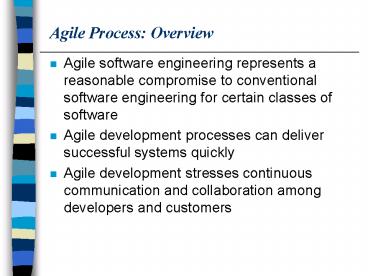Agile Process: Overview - PowerPoint PPT Presentation
1 / 13
Title:
Agile Process: Overview
Description:
Agile Process: Overview Agile software engineering represents a reasonable compromise to conventional software engineering for certain classes of software – PowerPoint PPT presentation
Number of Views:133
Avg rating:3.0/5.0
Title: Agile Process: Overview
1
Agile Process Overview
- Agile software engineering represents a
reasonable compromise to conventional software
engineering for certain classes of software - Agile development processes can deliver
successful systems quickly - Agile development stresses continuous
communication and collaboration among developers
and customers
2
Manifesto for Agile Software Development
- Better to value
- Individuals and interactions over processes and
tools - Working software over comprehensive documentation
- Customer collaboration over contract negotiation
- Responding to change over following a plan
- While the items on the right are still important
the items on the left are more valuable under
this philosophy
3
What is Agility?
- Rapid and adaptive response to change
- Effective communication among all stakeholders
- Drawing the customer onto the team
- Organizing a team so that it is in control of the
work performed - Yielding
- Rapid, incremental delivery of software
4
Agile Teams
- are responsive to changes during project
development - recognize that project plans must be flexible
- eliminates the separation between customers and
developers
5
Agility
- encourages team structures that make
communication among developers and customers
easier - emphasizes importance of rapid delivery of
operational software and de-emphasizes importance
of intermediate work products - can be applied to any software process as long as
the project team is allowed to streamline tasks
and conduct planning in way that eliminate
non-essential work products
6
An Agile Process
- Is driven by customer descriptions of what is
required (scenarios) - Recognizes that plans are short-lived
- Develops software iteratively with a heavy
emphasis on implementation - Delivers multiple software increments
- Adapts as changes occur
7
Human Factors
- Traits that need to exist in members of agile
development teams - Competence
- Common focus
- Collaboration
- Decision-making ability
- Fuzzy-problem solving ability
- Mutual trust and respect
- Self-organization
8
Agile Process Models
- Extreme Programming (XP)
- Adaptive Software Development (ASD)
- Dynamic Systems Development Method (DSDM)
- Scrum
- Crystal
- Feature Driven Development (FDD)
- Agile Modeling (AM)
9
Extreme Programming (XP)
- The most widely used agile process, originally
proposed by Kent Beck - XP Planning
- Begins with the creation of user stories
- Agile team assesses each story and assigns a cost
- Stories are grouped to for a deliverable
increment - A commitment is made on delivery date
- After the first increment project velocity is
used to help define subsequent delivery dates for
other increments
10
Adaptive Software Development (ASD)
- Self-organization arises when independent agents
cooperate to create a solution to a problem that
is beyond the capability of any individual agent - Adaptive cycle characteristics
- Mission-driven planning
- Component-based focus
- Uses time-boxing
- Explicit consideration of risks
- Emphasizes collaboration for requirements
gathering - Emphasizes learning
11
Dynamic Systems Development Method
- Provides a framework for building and maintaining
systems which meet tight time constraints using
incremental prototyping in a controlled
environment - Uses Pareto principle (80 of project can be
delivered in 20 time required to deliver the
entire project) - Each increment only delivers enough functionality
to move to the next increment
12
Dynamic Systems Development Method
- Guiding principles
- Active user involvement
- Teams empowered to make decisions
- Fitness for business purpose is criterion for
deliverable acceptance - Iterative and incremental development needed to
converge on accurate business solution - All changes made during development are
reversible - Requirements are baselined at a high level
- Testing throughout life-cycle
13
Agile Modeling
- Practice-based methodology for effective modeling
and documentation of software systems in a
light-weight manner - Modeling principles
- Model with a purpose
- Use multiple models
- Travel light (only keep models with long-term
value) - Content is more important than representation
- Know the models and tools you use to create them
- Adapt locally































